
- _PDF Printed Notes
- _PPT Slides
- _PPT Slides in PDF format
- _Intext Questions & Answers
- _Exercise and Answers
- _MCQs and Answers
- _Online Test Series
- _Activity Solutions
- _PDF Printed notes
- _Capsule Notes
- _Class 10 PPT
- _Class 11 PPT
- _Class 12 PPT
- _Exam Capsule PPT
- Online Tests
- _Chemistry Notes
- _Animal Facts
- _Body Facts
- _Comparison between
- _What and Why

Our Environment | Class 10 CBSE | PPT full
Our environment: , ppt presentation, 👉 click here.
👉 Other PPT Slide Presentations 👉 Class 10: Notes, Presentations, Questions
- CBSE Notes For Class 10
- Class 10 Science Notes
- Chapter 15: Our Environment
CBSE Class 10 Chapter 15 Our Environment Notes
According to the CBSE Syllabus 2023-24, this chapter has been renumbered as Chapter 13.
CBSE Class 10 Science Chapter 15 Our Environment Notes
Introduction.
Environment refers to the surrounding of an organism where it thrives. It constitutes both living and non-living things, i.e. physical, chemical and biotic factors. Here, in this chapter, we will learn about various components of the environment, their interactions and how our activities affect the environment.
The ecosystem comprises all the biotic and abiotic factors interacting with one another in a given area. Biotic components include all living organisms such as plants, animals, microorganisms and humans, etc., and abiotic components include sunlight, temperature, air, wind, rainfall, soil and minerals, etc. E.g. pond ecosystem, grassland ecosystem , etc.
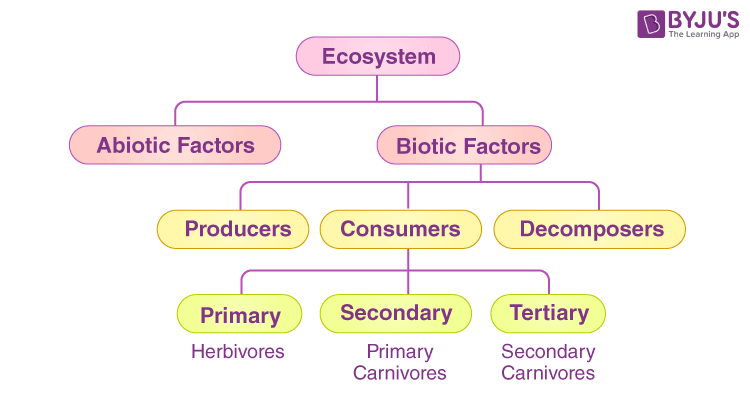
Watch the video below to learn about our environment and its components

Mode of Nutrition in Animals and Plants
Autotrophic and Heterotrophic are the two modes of nutrition in living organisms. Plants and some bacteria are autotrophic as they make their own food. Animals, fungi and some bacteria are heterotrophic as they derive their food from other organisms.
Read more: Difference between Autotrophs and Heterotrophs
Saprophytes and Decomposers
Saprophytes feed on dead and decaying material, e.g. fungi and microorganisms. They absorb nutrients from dead and decaying plants and animal parts. Decomposers break down the organic matter or waste material and release nutrients into the soil. For example, bacteria, worms, slugs, and snails. They are considered extremely important in soil biology. They break down the complex organic matter into simpler substances that are taken up by the plants for various metabolic activities.
Read more: Saprophytes
Abiotic Components
Non-living chemical and physical components of the environment like the soil, air, water, temperature, etc.
Biotic Components
Living organisms of the environment like plants, animals, microbes and fungi.
Read more: Biotic and Abiotic
Trophic Levels
It refers to the various levels in a food web as per the flow of energy. The different trophic levels are –
- Producers (T1)
- Primary consumers (herbivores-T2)
- Secondary consumers (primary carnivores -T2)
- Tertiary consumers(Sec carnivores -T3)
- Quaternary consumers (Ter. carnivores T4)
- Decomposers
Also see: What do you understand by trophic level?
Pyramid of Trophic Levels
- Is a graphical representation.
- Can be the pyramid of numbers, the pyramid of biomass or the pyramid of energy.
- Start with producers.
a) Pyramid of numbers : gives the number of organisms present at each trophic level. It can be upright or inverted. b) Pyramid of biomass: gives the biomass of each trophic level and could be upright or inverted. c) Pyramid of energy: is always upright as it shows the flow of energy from one trophic level to the next trophic level.
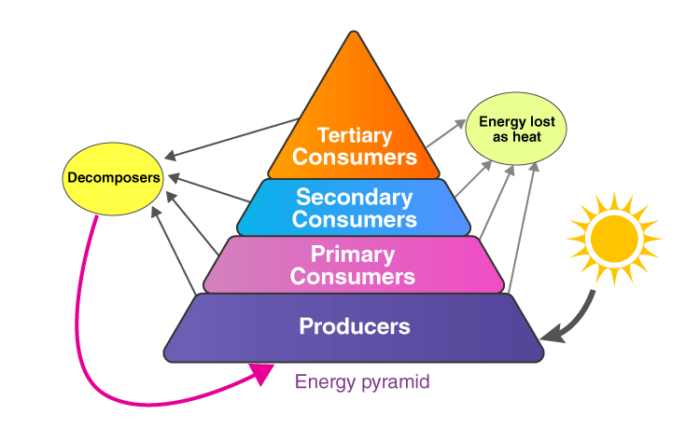
To know more about different types of ecological pyramids, visit here .
Law of Conservation of Energy
- Energy can neither be created nor destroyed; rather, it transforms from one form to another.
- In biological systems, it gets passed from one organism to another across trophic levels.
To know more about the Law of conservation of energy, visit here .
Energy Flow
- Transfer of energy from one trophic level to another depicting its direction and amount.
- Represented by the pyramid of energy.
- In any food chain, only 10% of the energy is transferred from one trophic level to another.
To know more about Energy Flow in Ecosystem, visit here .
A series of organisms, each dependent on the next as a source of food.

To know more about Food Chain, visit here .
- Is formed by interconnections of different food chains.
- Is a graphical representation of ‘Who eats Whom’ in an ecosystem.

To know more about Food Web, visit here .
Characteristics of Ecosystem
- Includes the summary of trophic levels.
- Their energy flow and pyramids.
Environment
- Includes all living and nonliving things.
- Unlike ecosystems, there need not be any necessary interaction between them.
Also see: Our Environment
Pollution is the introduction of harmful materials (pollutants) into the environment. Pollution can be due to natural causes, such as volcanic eruptions, forest fires, etc. or due to human activities, such as carbon emission, industrial runoff, etc.
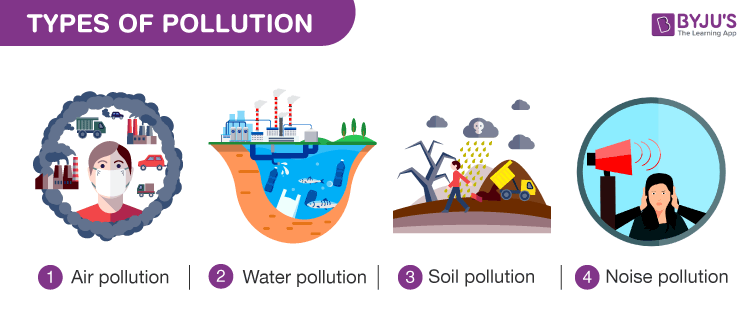
Know more: Types of Pollution
Air Pollution
Introduction of pollutants, organic molecules, or other hazardous substances into the earth’s atmosphere. Sources: a) Natural – forest fire, dust storms, and volcanic activity b) Man-made – power plants, homes, industries, oil refineries, and transportation
To know more about Air Pollution, visit here .
Ozone Layer Depletion
The ozone layer protects the Earth from the sun’s ultraviolet (UV) radiation. CFCs released into the atmosphere react chemically with ozone molecules and deplete the layer.
For more information on Ozone Layer Depletion, watch the video below

Know more: Ozone Layer Depletion
Garbage Management
- Involves all the activities and actions required to manage waste from its inception to its final disposal.
- Ensures environmental best practices are followed along with proper monitoring and regulation.
Steps involved: 1. Segregation of waste 2. Collection 3. Transport 4. Treatment 5. Processing & Recycling 6. Disposal

For more information on Waste Disposal, watch the video below
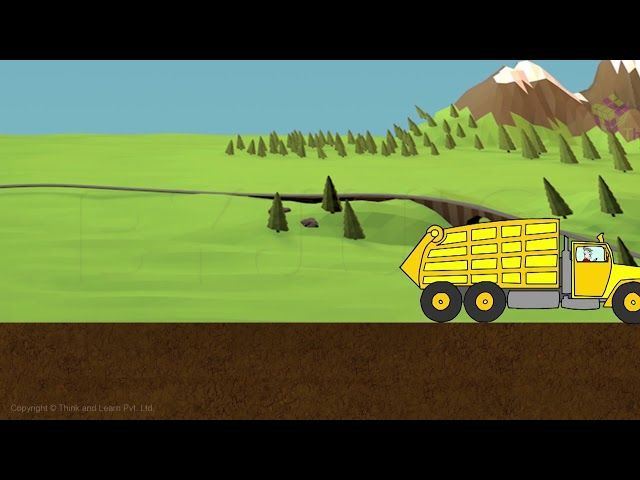
Read more: Solid Waste Management
Biodegradable Waste
- Waste is derived from plants or animals.
- Decomposed into the soil by a natural agent such as weather, water, air, heat, micro-organisms, etc.
Watch the video below to know more about Biodegradable and Non-biodegradable waste
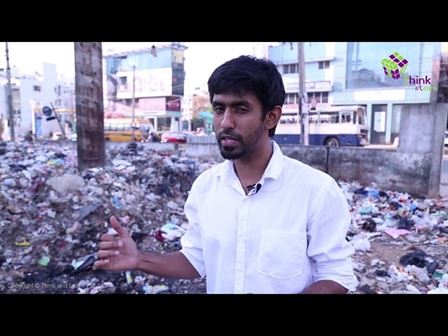
Biodegradation
Decomposition of garbage or waste material by living organisms or biological processes.
To know more about Different Types of Pollution, visit here .
Frequently Asked Questions on CBSE Class 10 Science Notes Chapter 15 Our Environment
What are the different types of landforms present in our environment.
Mountains, hills, plateaus and plains are the four major types of landforms which are majorly present in our environment.
What is lithosphere’?
The lithosphere is the rocky outer part of the Earth. It is made up of the brittle crust and the top part of the upper mantle.
Where is the biosphere present?
The biosphere makes up the portion of the Earth where life exists.
Also Check:
- CBSE Class 10 Science Chapter 14 Sources of Energy Notes
- Real Numbers Class 10 Notes: Chapter 1
- NCERT Exemplar Class 10 Science Solutions for Chapter 15 – Our Environment
- NCERT Solutions for Class 10 Science Chapter 15: Our Environment

Leave a Comment Cancel reply
Your Mobile number and Email id will not be published. Required fields are marked *
Request OTP on Voice Call
Post My Comment
- Share Share
Register with BYJU'S & Download Free PDFs
Register with byju's & watch live videos.
Our Environment - PowerPoint Presentation, Biology, Class 10 - IT & Software PDF Download
Top courses for it & software, faqs on our environment - powerpoint presentation, biology, class 10 - it & software, class 10 - it & software, study material, viva questions, our environment - powerpoint presentation, past year papers, important questions, objective type questions, video lectures, extra questions, previous year questions with solutions, sample paper, mock tests for examination, semester notes, practice quizzes, shortcuts and tricks.

Our Environment - PowerPoint Presentation, Biology, Class 10 Free PDF Download
Importance of our environment - powerpoint presentation, biology, class 10, our environment - powerpoint presentation, biology, class 10 notes, our environment - powerpoint presentation, biology, class 10 it & software questions, study our environment - powerpoint presentation, biology, class 10 on the app, welcome back, create your account for free.

Forgot Password
Unattempted tests, change country, practice & revise.

CHAPTER - 15 OUR ENVIRONMENT
Aug 11, 2012
2.71k likes | 8.89k Views
CHAPTER - 15 OUR ENVIRONMENT. CLASS :- X MADE BY :- MANAS MAHAJAN SCHOOL :- K.V. GANESHKHIND PUNE-7. 1. Effect of adding waste to the environment :-. Human activities produce a lot of waste materials which
Share Presentation
- different types
- mahajan school
- dead plants
- harmless substances
- free oxygen atoms
- oxygen molecules

Presentation Transcript
CHAPTER - 15OUR ENVIRONMENT CLASS:- X MADE BY :- MANAS MAHAJAN SCHOOL :- K.V. GANESHKHIND PUNE-7
1. Effect of adding waste to the environment :- Human activities produce a lot of waste materials which are thrown away into the environment. These wastes cause pollution of air, water and soil. The waste materials produced are of two main types. They are biodegradable wastes and non biodegradable wastes. i) Biodegradable wastes :- are wastes which are decomposed into harmless substances by microorganisms. Eg :- vegetables, fruits, pulses, cereals, cotton, jute, wool, wood, leather, paper, animal dung, animal bones etc. ii) Non biodegradable wastes :- are wastes which are not decomposed by microorganisms. Eg :- polythene bags, plastics, synthetic fibres, glass, metals, synthetic rubber, insecticides, pesticides etc.
2. Ecosystem and its components :- a) Ecosystem :- An ecosystem consists of all the living organisms in an area along with the non living components and their interaction. There are different types of ecosystems. They are :- i) Natural ecosystems :- like forests, deserts, grass lands, mountains, ponds, lakes, rivers, oceans etc. ii) Artificial ecosystems :- like gardens, parks, crop fields, aquarium, zoo etc. b) Components of an ecosystem :- An ecosystem consists of two main components. They are biotic and abiotic components. i) Biotic components :- are the living components like plants, animals and microorganisms. They consist of producers, consumers and decomposers. Producers :- are green plants which produce food by photosynthesis. Consumers :- are herbivores which get their food directly from plants, carnivores which get their food indirectly from plants and omnivores which get their food directly or indirectly from plants. Decomposers :- are microorganisms which decompose dead plants and animals. They decompose complex organic substances into simple inorganic substances in the soil which are again used by plants. ii) Abiotic components :- are the non living components like air, water, soil, minerals, sunlight , temperature, wind etc.
3a) Food chain :- A food chain is the flow of food energy from one organism to the next and to the next and so on. They usually start with a producer (plants) and end with a carnivore. In a food chain an organism gets food from one group of organisms. eaten by eaten by Eg:- Grass Deer Lion (producer) (primary consumer) (secondary consumer) eaten by eaten by eaten by Grass Insects Frog Snake (producer) (primary consumer) (secondary consumer) (tertiary consumer) eaten by eaten by eaten by eaten by Grass Moth Frog Snake Hawk (producer) (primary consumer) (secondary consumer) (tertiary consumer) (quarternary consumer)
b) Food web :- Food web is a group of several interconnected food chains. In a food web an organism gets food from more than one group of organisms.
4) Trophic levels :- Each step in a food chain where transfer of food energy takes place is called trophic level. The first trophic level consists of producers. The second trophic level consists of primary consumers. The third trophic level consists of secondary consumers. The fourth trophic level consists of tertiary consumers. Since the transfer of food energy decreases at every trophic level, the number of trophic levels are limited and do not exceed four or five.
5) Energy flow in trophic levels :- Green plants (producers) absorb about 1% of solar energy falling on the leaves and stores it as food energy during photosynthesis. During the transfer of food energy from one trophic level to the next, 90% of the energy is lost to the environment and only 10% is transferred to the next trophic level. So there is a decrease in the amount of food energy transferred at every trophic level by 10%. This is known as the 10% law.
6) Biological magnification (Biomagnification) :- Harmful chemicals like insecticides and pesticides which are used to protect crops from insects and pests are absorbed by plants and enter the food chain. Since these chemicals are non biodegradable, they get accumulated at every trophic level and their concentration increases. Since human beings occupy the highest trophic level, the concentration of these harmful chemicals is maximum in our bodies. The increase in concentration of harmful chemicals in the bodies of organisms at higher trophic levels is called biological magnification.
7) Human activities affect the environment :- a) Depletion of ozone layer in the atmosphere :- Ozone molecule contains three oxygen atoms (O3). At higher levels in the atmosphere the UV radiation splits some oxygen molecules (O2) into free oxygen atoms which combines with oxygen molecules (O2) to form ozone. It is highly poisonous. UV radiation O2 O + O O2 + O O3 The ozone layer present in the higher layer of the atmosphere protects the earth from the harmful UV radiation from the sun. UV radiation causes skin cancer in humans. The ozone layer is being damaged by the use of chemicals like chloro fluoro carbons (CFCs) used in refrigerators and fire extinguishers. So the use of CFCs is now being reduced to protect the ozone layer.
b) Managing the garbage we produce :- The household waste is called garbage. Some of the garbage is biodegradable and some are non biodegradable. Garbage causes pollution of air, water and soil. So it should be disposed properly. Some of the methods of garbage disposal are :- i) Land fills ii) Recycling iii) Production of biogas and manure iv) Preparation of compost v) Incineration vi) Sewage treatment
Land fills Recycling Production of biogas and manure Preparation of compost
Incinerator
Sewage treatment
- More by User
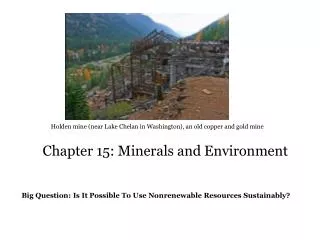
Chapter 15: Minerals and Environment
Chapter 15: Minerals and Environment Holden mine (near Lake Chelan in Washington), an old copper and gold mine Big Question: Is It Possible To Use Nonrenewable Resources Sustainably? Case Study
843 views • 21 slides
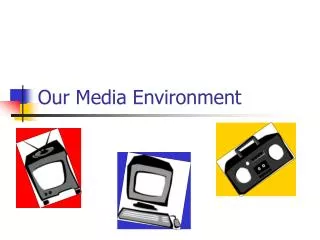
Our Media Environment
Our Media Environment. Pervasive in Modern Life. Information Source Entertainment Source Persuasion Forum Binding Influence. Uses & Gratifications Theory. Goal directed or purposive Active users who select media Social & psychological factors
1.54k views • 8 slides

Chapter 15: Minerals and Environment . Holden mine (near Lake Chelan in Washington), an old copper and gold mine. Big Question: Is It Possible To Use Nonrenewable Resources Sustainably?. Case Study.
466 views • 21 slides
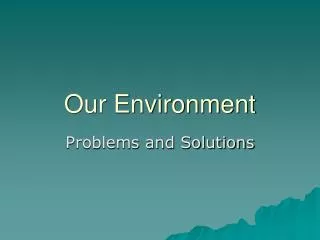
Our Environment
Our Environment. Problems and Solutions. Problem: Too much trash!. All our trash has to go somewhere It goes to dumps and landfills We are running out of space to put our trash. How can you help?. Recycle: Newspapers Glass bottles Plastic bottles Aluminum cans Hazardous waste
427 views • 17 slides

Our Environment. We will exercise on Microsoft Visual C++ v.6 because that is what we have in the univ. but there are many free compilers, too. Visual C++ (v6). Visual C++ (v6). New.. Ctrl+N. Visual C++ (v6). proje ct title (name of .exe). Project and file directory.
511 views • 29 slides

Chapter 1 Understanding Our Environment
Chapter 1 Understanding Our Environment . What Is Environmental Science? . Current Conditions . We Live On A Marvelous Planet No other known planet is remotely habitable We Face Many Serious Environmental Problems There Are Also Many Signs of Hope Calculating Your Ecological Footprint
294 views • 15 slides
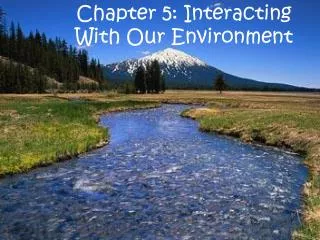
Chapter 5: Interacting With Our Environment
Chapter 5: Interacting With Our Environment. Section 1: Natural Resources. VOCABULARY. Natural Resources Raw Materials Renewable Resources Non-renewable Resources. Useful materials found in the environment Natural resources that must be worked to be useful
362 views • 24 slides

Our Environment. The Eden project. The Weee man was designed by Paul Bonomini it is a huge scrap of metal created into a sculpture with represents how much we throw away in our lifetime It weighs 3.3 tones and seven metres tall
202 views • 5 slides

Petr Sovadina Jan Hrkalík 8.Class 2013/2014. Our Environment. Talking about our environment.
341 views • 9 slides
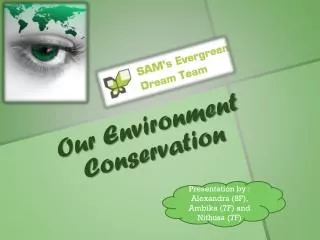
Our Environment Conservation
Our Environment Conservation. Presentation by : Alexandra (8F), Ambika (7F) and Nithusa (7F). SAM is an Eco school. We received the GOLD certification since we created the Green Team. Let’s continue this tradition!. 1 . Reduce
593 views • 8 slides

Chapter 1 Our Changing Environment
Chapter 1 Our Changing Environment. Bethany Lavins 7 th period. An example of a building using green architecture, integrating wind turbines, photovoltaic panels and solar hot water generation. Objective 1.
452 views • 33 slides

Our Environment. Our planet should be safe to live on. Our country should be powerful and happy to live in. Our air should be unpolluted and clean to breathe. It is dangerous to breathe. Make Clean Air laws. Our rivers, lakes and seas should be clean and not dangerous to bathe in.
310 views • 14 slides

Preserving our environment
Preserving our environment. Fostering collaboration among our communities. Historical Perspective: Protected and Productive Watershed. State/county definition of Herring Bay watershed. Geographic Perspective. For now, AHB is focusing on areas that flow directly into Herring Bay.
231 views • 14 slides

Our environment
Our environment. What are we doing to our planet?. Some facts. We have caused over 40% of the world´s rainforests to disappear. We have polluted the air, the sea and the land. We have killed lots of species of animals and plants.
358 views • 17 slides

Understanding Our Environment
Understanding Our Environment. Definitions. Environmental science – the study of how humans interact with the environment Environment – everything that surrounds us – the natural world along with human products. What’s the Problem???. Resource Depletion.
1.02k views • 33 slides

Our Learning environment
Our Learning environment. Conor and Thomas. Code of conduct. Show respect and cooperation Keep our school tidy and safe Have fun and enjoy your learning environment Be honest be kind and think of other peoples feelings Remember to be polite These are the rules of the school.
155 views • 5 slides

ALICANTE: OUR ENVIRONMENT
96 views • 2 slides
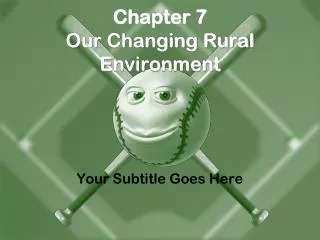
Chapter 7 Our Changing Rural Environment
Chapter 7 Our Changing Rural Environment. Your Subtitle Goes Here. Learning Goals. Compare three major settlement patterns in Canada Find out about modern rural Canada See how rural land is becoming urban land. Settlement Patterns.
514 views • 30 slides
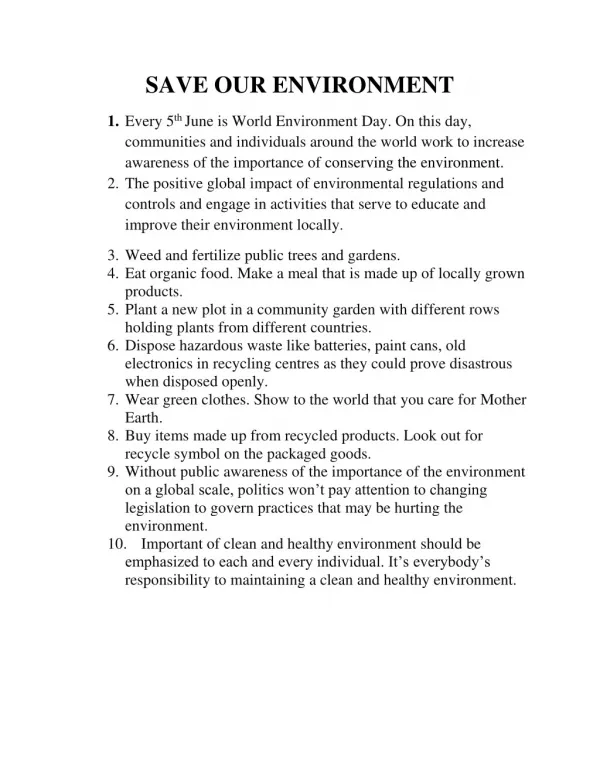
Save Our Environment
Niyatee Foundation is a social service organization in bhubaneswar trying to do some changes for the society through arranging skill development program, awareness program and other social activates. http://www.niyateefoundation.org/
134 views • 1 slides
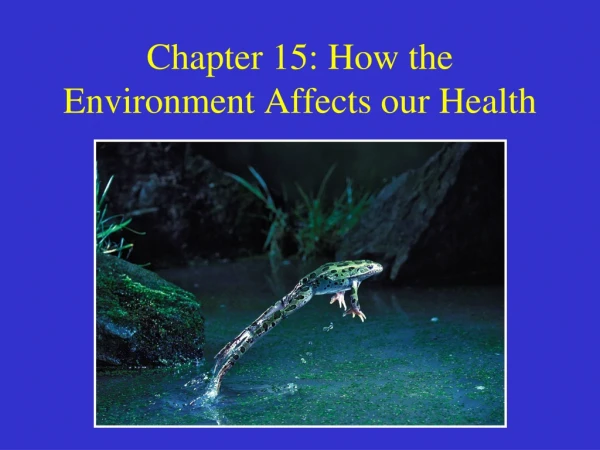
Chapter 15: How the Environment Affects our Health
Chapter 15: How the Environment Affects our Health. Disease. Disease is often due to an imbalance resulting from poor adjustment between the individual and the environment. Continuum from state of health to disease Gray zone in-between
532 views • 50 slides
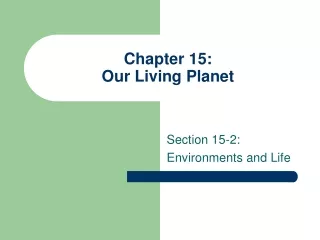
Chapter 15: Our Living Planet
Chapter 15: Our Living Planet. Section 15-2: Environments and Life. Life Affects Environments. Think about a grassland or forest . . . Organisms affect the environment 3 billion years ago when photosynthetic bacteria began releasing oxygen into the atmosphere. Life Affects Environments.
99 views • 9 slides

Our Environment. Problems and Solutions. Vocabulary Preview. hazardous = dangerous, causing hurt waste = trash, things we don’t need pollute = make dirty pollution = the dirt, smog, etc. in the air and water landfill = a place to put a lot of trash conserve = save, use less
482 views • 33 slides

Science Presentation for Class 10
Chapter 1: chemical reaction and equation, chapter 2: acid bases and salts, chapter 3: metals and non-metals, chapter 4: carbon and its compounds, chapter 5: periodic classification of elements, chapter 6: life process, chapter 7: control and coordination, chapter 8: how do organism reproduce, chapter 9: heredity and evolution, chapter 10: light reflection and refraction, chapter 11: human eye and the colourful world, chapter 12: electricity, chapter 13: magnetic effects of electricity, chapter 14: sources of energy, chapter 15: our environment, chapter 16: sustainable management of natural resources.

Amazon Affiliate Disclaimer: cbsecontent.com is a part of Amazon Services LLC Associates Program, an affiliate advertising program designed to provide a means for sites to earn advertising fees by advertising and linking to Amazon.in. As an amazon associates we earn from qualifying purchases.
“Mcqquestions.net is your go-to resource for Class 10 Science MCQ Questions tailored for exams. If you’re a student gearing up for your Class 10 Science exam, you’ll find an extensive collection of multiple-choice questions on this platform. Covering various topics and concepts from the science curriculum, these MCQs offer a valuable way to assess and strengthen your knowledge. Prepare with confidence as you engage with well-structured questions that align with the exam format. mcqquestions.net is dedicated to helping you excel in your Class 10 Science exam. Explore the MCQs now and boost your exam readiness!”
This is my first time pay a quick visit at here and i am really happy to read everthing at one place

IMAGES
VIDEO
COMMENTS
Our Environment Class - 10th. The document discusses key concepts relating to ecosystems, including: 1) An ecosystem consists of interacting biotic and abiotic components. Biotic components are living organisms while abiotic components are non-living physical and chemical elements like temperature, rainfall, soil etc. 2) There are two main ...
Class 10-chapter-15-our environment - Download as a PDF or view online for free. Class 10-chapter-15-our environment - Download as a PDF or view online for free ... PowerPoint Presentation on the topic - 'Our Environment'. For Class - 10th. Created By - 'Neha Rohtagi' I hope that you will found this presentation useful and it will help you out ...
PDF Notes, PPTs, Online Tests and Question Banks for Class 10, Class 11, Class 12, NEET etc.
The ozone layer present in the higher layer of the atmosphere protects the earth from the harmful UV radiation from the sun. UV radiation causes skin cancer in humans. The ozone layer is being damaged by the use of chemicals like chloro fluoro carbons (CFCs) used in refrigerators and fire extinguishers. So the use of CFCs is now being reduced ...
H. HudaFathima3. Our environment, Grade 10, Biology. This power point presentation explains the topic 'Our Environment' of grade 10 cbse. Environment. 1 of 21. Download now. Our Environment: Ecosystems and Their Components - Download as a PDF or view online for free.
The 10% Law. producers capture 1% of the sunlight energy (10J out of 1000J of sun's energy) average of 10% of the food eaten is turned into primary consumer's own body (10J) secondary consumer absorbs 10% of primary consumer's enegy (1J) tertiary consumer (0.1J) That is why only 3-4 trophic levels in a food chain.
The "PPT - Our Environment Class 10 Questions" guide is a valuable resource for all aspiring students preparing for the Class 10 exam. It focuses on providing a wide range of practice questions to help students gauge their understanding of the exam topics. These questions cover the entire syllabus, ensuring comprehensive preparation.
The "PPT: Our Environment Class 10 Questions" guide is a valuable resource for all aspiring students preparing for the Class 10 exam. It focuses on providing a wide range of practice questions to help students gauge their understanding of the exam topics. These questions cover the entire syllabus, ensuring comprehensive preparation.
This video is a PowerPoint presentation of class 10th chapter 15 of the science book.
*Class 10/ CBSE Science Notes, PPTs, Q & A, Activity solutions etc.*https://www.bankofbiology.com/p/cbse-class-10.html
Page 10 : 7) Human activities affect the environment :-, a) Depletion of ozone layer in the atmosphere :-, Ozone molecule contains three oxygen atoms (O3). At higher levels in the atmosphere the UV radiation splits some oxygen molecules (O2) into free oxygen atoms which combines with oxygen molecules (O2) to form ozone.
#OURENVIRONMENT#FULLCHAPTEROur Environment in Full chapter (Animation) | CBSE Class 10 Biology ch13 | ecosystem | NCERT Science*****Class 1... CBSE Exam, class 10
OUR ENVIRONMENT.ppt.pptx. OUR ENVIRONMENT.ppt.pptx JaiPrakash520586 ... Class 10 Ch 12 Our environment Notes Ex.pdf EXCELLENT CLASSES ...
Our Environment Class 10 - Free download as Powerpoint Presentation (.ppt / .pptx), PDF File (.pdf), Text File (.txt) or view presentation slides online. Scribd is the world's largest social reading and publishing site.
OUR ENVIRONMENT PPT Class 10 chapter 15 Science NCERT book BY AAMIL SAIYED
Bio Our Environment - Free download as Powerpoint Presentation (.ppt / .pptx), PDF File (.pdf), Text File (.txt) or view presentation slides online. Scribd is the world's largest social reading and publishing site.
Introduction. Environment refers to the surrounding of an organism where it thrives. It constitutes both living and non-living things, i.e. physical, chemical and biotic factors. Here, in this chapter, we will learn about various components of the environment, their interactions and how our activities affect the environment.
Introduction of Our Environment - PowerPoint Presentation, Biology, Class 10 in English is available as part of our IT & Software preparation & Our Environment - PowerPoint Presentation, Biology, Class 10 in Hindi for IT & Software courses. Download more important topics, notes, lectures and mock test series for IT & Software Exam by signing up ...
23 likes • 37,596 views. A. Amaan Siddiqui. Our environment's ppt specially for students of class 10th.... Education Business Technology. 1 of 28. Download now. PPT On Our environmet - Download as a PDF or view online for free.
Presentation Transcript. CHAPTER - 15OUR ENVIRONMENT CLASS:- X MADE BY :- MANAS MAHAJAN SCHOOL :- K.V. GANESHKHIND PUNE-7. 1. Effect of adding waste to the environment :- Human activities produce a lot of waste materials which are thrown away into the environment. These wastes cause pollution of air, water and soil.
Next Post →. Science Presentation for Class 10 Science Chapter 1: Chemical Reaction and Equation Click Here Click Here Chapter 2: Acid Bases and Salts Click Here Click Here Chapter 3: Metals and Non-Metals Click Here Click Here Chapter 4: Carbon and its Compounds Click Here Click Here Chapter 5: Periodic Classification of Elements Click Here ...
project on Our Environment for class 10 - Free download as Powerpoint Presentation (.ppt / .pptx), PDF File (.pdf), Text File (.txt) or view presentation slides online. power point presentation 2003
6 likes • 3,455 views. K. Kushal T. A power point presentation on the class 10 science biology lesson"OUR ENVIRONMENT".It consists of more informations beyond syllabus.It will be more useful for IIT aspirants. Read more. Environment. 1 of 28. Download now. Our Environment - Download as a PDF or view online for free.